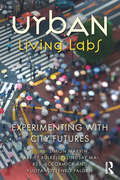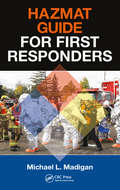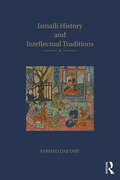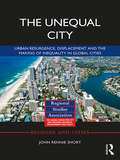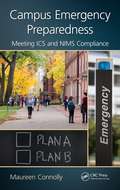- Table View
- List View
Using Anthropology in the World: A Guide to Becoming an Anthropologist Practitioner
by Riall W. NolanAnthropologist practitioners work outside the confines of the university, putting their knowledge and skills to work on significant problems in a wide variety of different contexts. The demand for anthropologist practitioners is strong and growing; practice is in many ways the leading edge of anthropology today, and one of the most exciting aspects of the discipline. How can anthropology students prepare themselves to become practitioners? Specifically designed to help students, including those in more traditional training programs, prepare for a career in putting anthropology to work in the world, the book: - provides an introduction to the discipline of anthropology and an exploration of its role and contribution in today’s world;- outlines the shape of anthropological practice – what it is, how it developed historically, and what it looks like today;- describes how students of anthropology can prepare for a career in practice, with emphasis on the relationship between theory, method, and application; - includes short contributions from practitioners, writing on specific aspects of training, practice, and career planning;- sets out a framework for career planning, with specific and detailed discussions of finding and securing employment; - reviews some of the more salient challenges arising in the course of a practitioner career; and- concludes with a discussion of what the future of anthropological practice is likely to be. Using Anthropology in the World is essential reading for students interested in preparing themselves for the challenges and rewards of practice and application.
Urban Living Labs: Experimenting with City Futures
by Simon Marvin Harriet Bulkeley Lindsay Mai Kes McCormick Yuliya Voytenko PalganAll cities face a pressing challenge – how can they provide economic prosperity and social cohesion while achieving environmental sustainability? In response, new collaborations are emerging in the form of urban living labs – sites devised to design, test and learn from social and technical innovation in real time. The aim of this volume is to examine, inform and advance the governance of sustainability transitions through urban living labs. Notably, urban living labs are proliferating rapidly across the globe as a means through which public and private actors are testing innovations in buildings, transport and energy systems. Yet despite the experimentation taking place on the ground, we lack systematic learning and international comparison across urban and national contexts about their impacts and effectiveness. We have limited knowledge on how good practice can be scaled up to achieve the transformative change required. This book brings together leading international researchers within a systematic comparative framework for evaluating the design, practices and processes of urban living labs to enable the comparative analysis of their potential and limits. It provides new insights into the governance of urban sustainability and how to improve the design and implementation of urban living labs in order to realise their potential.
HAZMAT Guide for First Responders
by Michael L. MadiganThe goal of this book is to help train hazmat response teams and other responders in disaster training, techniques, and planning.The book will also help define and sharpen training plans and assumptions. Focusing on lessons learned from real-world experiences during actual disasters, the book will help to establish a well-trained professional 1st responder, individuals, and teams. Such lessons are emphasized so that planners and responders learn to anticipate how their community is likely to react under real disaster conditions, and plan accordingly.
Understanding and Responding to Child Sexual Exploitation
by Helen Beckett Jenny PearceThe issue of child sexual exploitation (CSE) has received intense scrutiny in recent years, following a number of high profile legal cases, serious case reviews and inquiries. This has resulted in increasing expectations that those working in the field will know how to appropriately manage and respond to this form of abuse. Of course, this is no easy task given the widely acknowledged difficulties of identifying and responding to sexual abuse and the particular complexities associated with the gain dynamic within CSE and the predominantly older age of children affected by it. This edited collection draws on the latest research evidence and academic thinking around CSE to consider issues of understanding and response. Written by researchers from ‘The International Centre: Researching child sexual exploitation, violence and trafficking’ at the University of Bedfordshire, Part I considers issues of understanding and conceptualisation. Part II considers the practical implications of some of this thinking, sharing learning from research and evaluation on prevention, identification and response. Understanding and Responding to Child Exploitation presents critical learning for academics and students, and for those working in the fields of policy, practice and commissioning. It is relevant to a wide range of disciplines including social care, youth work, education, criminology, health and social policy.
The Social Work and K-12 Schools Casebook: Phenomenological Perspectives
by Miriam Jaffe Jerry Floersch Jeffrey Longhofer Wendy WinogradThis volume offers a collection of nine case studies from clinical social workers in K-12 schools, each from a phenomenological perspective, with the objective of educating Master of Social Work students and early career social work clinicians. Each chapter is framed with pre-reading prompts, reading comprehension questions, and writing assignments. This casebook provides a resource for understanding the range of practice in school social work as well as some of the challenges that school social workers face in today’s complex world. Using a phenomenological perspective the contributors stay close to the lived experience of students, teachers, parents, and social workers, revealing a deeper and more nuanced understanding of the genesis and treatment of students’ problems in school.
Life Course, Happiness and Well-being in Japan (Nissan Institute/Routledge Japanese Studies)
by Barbara Holthus Wolfram ManzenreiterMuch of the existing literature on happiness in Japan has been produced in the field of economics and psychology and is quantitative in nature. Here, for the first time, a group of anthropologists and sociologists jointly analyze the state of happiness and unhappiness in Japan among varying social groups in its physical, interpersonal, existential and structural dimensions, offering new insights into fundamental issues. This book investigates the connections between sociostructural aspects, individual agency and happiness in contemporary Japan from a life course perspective. The contributors examine quantitative and qualitative empirical data on the processes that impact how happiness and well-being are envisioned, crafted, and debated in Japan across the life-cycle. Therefore, the book discusses the shifting notions of happiness during people’s lives from birth to death, analyzing the age group-specific experiences while taking into consideration people’s life trajectories and historical changes. It points out recent developments in regards to demographic change, late marriage, and the changing labor market and focuses on their significant impact on the well-being of Japanese people. In particular it highlights the interdependencies of lives within the family and how families are collaborating for the purpose of maintaining or enhancing the happiness of its members. Broadening our understanding of the multidimensionality of happiness in Japan, this book will be of interest to students and scholars of Japanese Studies, Anthropology, and Sociology.
Ismaili History and Intellectual Traditions
by Farhad DaftaryThe Ismailis represent an important Shiʿi Muslim community with rich intellectual and literary traditions. The complex history of the Ismailis dates back to the second/eighth century when they separated from other Shiʿi groups under the leadership of their own imams. Soon afterwards, the Ismailis organised a dynamic, revolutionary movement, known as the daʿwa or mission, for uprooting the Sunni regime of the Abbasids and establishing a new Shiʿi caliphate headed by the Ismaili imam. By the end of the third/ninth century, the Ismaili dāʿīs, operating secretly on behalf of the movement, were active in almost every region of the Muslim world, from Central Asia and Persia to Yemen, Egypt and the Maghrib. This book brings together a collection of the best works from Farhad Daftary, one of the foremost authorities in the field. The studies cover a range of specialised topics related to Ismaili history, historiography, institutions, theology, law and philosophy, amongst other intellectual traditions elaborated by the Ismailis. The collation of these invaluable studies into one book will be of great interest to the Ismaili community as well to anyone studying Islam in general, or Shiʿi Islam in particular.
Populism: An Introduction (Key Ideas)
by Manuel AnselmiPopulism: An Introduction is the first introduction to the theme of populism. It will introduce the principal theories, definitions, models and contemporary debates. A number of global case studies will be used to illustrate the concept: • Russian populism; • Latin American populism; • Italian populism; • Peronism; • Media populism; • Penal populism; • Constitutional populism. Populism will reflect on the sociology of democratic processes and investigate the evolution of political consensus in contemporary political systems. This book will appeal to academics and postgraduate students working in the field of sociology, political sociology and politics.
Therapy with Harming Fathers, Victimized Children and their Mothers after Parental Child Sexual Assault: Forging Enduring Safety
by Dale Tolliday Jo Spangaro Lesley Laing'This book explores with refreshing clarity the complexities and challenges of working with child sexual abuse in the family environment. Describing a victim-centred, family approach based on clear ethical principles and with reference to their own practice experiences, Tolliday, Spangaro and Laing offer a resource which will be of huge practical use for any professional working to address child sexual abuse.' - Simon Hackett, Professor of Child Abuse and Neglect, Durham University.
State Repression in Post-Disaster Societies
by Clair ApodacaA natural hazard is a physical event but a disaster is a social and political phenomenon. Natural hazards are, for the most part, unavoidable and apolitical. However, they carry with them serious political, economic, and social consequences. Disasters also have adverse consequences on human rights standards. An understanding of the relationship between disasters and human rights outcomes requires knowledge of how disasters increase grievance and frustration, and impact the probability of contentious political behavior. To date, there has been little empirical or theoretical research on the specific circumstances under which disasters impact antigovernment political behavior, and even less is known of the causal chain between a natural disaster, protest activity, and human rights violations. In this book, Clair Apodaca maps a comprehensive causal model of the complex interactions between disasters and human rights violations. She claims that pre-existing inequalities and societal grievances turn a natural hazard into a disaster. A grievance-based theory of protests suggests that the underlying structural causes are social and economic group disparities, political exclusion, along with population pressures. To turn these all too common conditions into active political behavior requires a triggering event. When a damage–loss is the primary consequence of a disaster, the government and international community can compensate victims by providing rebuilding and reconstruction aid. However, when the disaster results in high numbers of fatalities, the government and international community cannot adequately compensate survivors for their losses. Grievances cannot be easily or effectively eliminated, and survivors and their supporters mobilize for change even if they are likely to face state repression. Clair Apodaca offers a unique contribution to our understanding of human rights violations. She effectively shows that there is a causal process between hazard events, protest activities, and government repression, a finding that is key to scholars, practitioners, and policy-makers working in this field.
Scientific and Political Freedom in Islam: A Critical Reading of the Modernist-Apologetic School
by Uriya ShavitThe modernist-apologetic approach to the relation between revelation and science and politics has been a central part of Arab discourses on the future of Muslim societies for over a century. This approach introduced historical and theological narratives and interpretative mechanisms that contextualize reason and freedom in Islamic terms to argue that, unlike with Christianity, it is possible for Muslim societies to be technologically and politically advanced without forfeiting revelation as an all-encompassing, legally-binding guide. ‘Scientific and Political Freedom in Islam’ critically examines the coherence and consistency of modernist-apologetic scholars. This is done through a discussion of their general theorizing on reason and freedom, which is then followed by discussions of their commentaries on specific scientific and political issues in light of their general theorizing. Regarding the former, the focus is Darwin’s theory of evolution, while the universality of the "Biblical flood," the heliocentric model, the Big Bang model and Freudianism are also discussed. Regarding the latter, the focus is Islam’s desired structure of government and concept of participatory politics, while individual freedoms are also discussed. The book argues that the modernist-apologetic approach has great potential to be a force for liberalization, but also possesses inherent limitations that render its theory on the relation between revelation and freedom self-contradictory. Introducing a significant body of new information on the reasons for the failure of secularism and democracy and the attitudes towards Darwinism in the Arab world, this book is a valuable resource for students and scholars of Islamic Studies, comparative religion, democracy studies and evolution studies.
Numeracy as Social Practice: Global and Local Perspectives (Rethinking Development)
by Keiko Yasukawa Alan Rogers Kara Jackson Brian V. StreetLearning takes place both inside and outside of the classroom, embedded in local practices, traditions and interactions. But whereas the importance of social practice is increasingly recognised in literacy education, Numeracy as Social Practice: Global and Local Perspectives is the first book to fully explore these principles in the context of numeracy. The book brings together a wide range of accounts and studies from around the world to build a picture of the challenges and benefits of seeing numeracy as social practice ̶ that is, as mathematical activities embedded in the social, cultural, historical and political contexts in which these activities take place. Drawing on workplace, community and classroom contexts, Numeracy as Social Practice shows how everyday numeracy practices can be used in formal and non-formal maths teaching and how, in turn, classroom teaching can help to validate and strengthen local numeracy practices. At a time when an increasingly transnational approach is taken to education policy making, this book will appeal to development practitioners and researchers, and adult education, mathematics and numeracy teachers, researchers and policy makers around the world.
Working with High-Risk Youth: A Relationship-based Practice Framework
by Peter SmythIn the child welfare system some youth do well in their lives, but far too many do not experience positive outcomes by the time they are leaving government services. The youth often feel marginalized and that they were not involved in decisions about their own lives, leaving them with a sense of hopelessness and helplessness. This book focuses on high-risk youth - whose struggles include neglect and abuse, alcohol and drug abuse, the risk of being exploited, mental health issues, and the inability to self-regulate and trust - a population of youth that government child welfare services and community agencies struggle to serve adequately. The focus has traditionally been on punishment-consequence interventions and demanding compliance, but experience and research shows they can be better served through relationship-based practice incorporating harm reduction principles, resiliency and strength-based approaches, community collaboration, and an understanding that these youth typically come from experiences of early trauma impacting their brain development and their ability to form attachments. This book provides an overview of the Get Connected practice framework and philosophy, and provides strategies for engaging and working with the most disconnected, challenging, and troubled youth in society.
Community-based Heritage in Africa: Unveiling Local Research and Development Initiatives
by Peter R. SchmidtThis volume provides a powerful alternative to the Western paradigms that have governed archaeological inquiry and heritage studies in Africa. Community-based Heritage Research in Africa boldly shifts focus away from top-down community engagements, usually instigated by elite academic and heritage institutions, to examine locally initiated projects. Schmidt explores how and why local research initiatives, which are often motivated by rapid culture change caused by globalization, arose among the Haya people of western Tanzania. In particular, the trauma of HIV/AIDS resulted in the loss of elders who had performed oral traditions and rituals at sacred places, the two most recognized forms of heritage among the Haya as well as distinct alternatives to the authorized heritage discourse favored around the globe. Examining three local initiatives, Schmidt draws on his experience as an anthropologist invited to collaborate and co-produce with the Haya to provide a poignant rendering of the successes, conflicts, and failures that punctuated their participatory community research efforts. This frank appraisal privileges local voices and focuses attention on the unique and important contributions that such projects can make to the preservation of regional history. Through this blend of personalized narrative and analytical examination, the book provides fresh insights into African archaeology and heritage studies.
Profit and Pleasure: Sexual Identities in Late Capitalism
by Rosemary HennessyProfit and Pleasure, Second Edition is a classic intervention into the relationship between capitalism and sexual identity. Rosemary Hennessy boldly reorients queer theory toward an up-close analysis of the structures of consumption, labor, and commodification, revealing how sexual identity—in the varied ways it has been culturally differentiated and lived—has been fundamentally affected by these principles of capitalism. In this second edition, a new introduction by the author reasserts a Marxist feminist standpoint as the most theoretically developed feminist analysis of capitalism’s cultural logics. She presents a range of key concepts—among them totality, overdetermination, social reproduction—outlining their evolution and continued relevance to analysis of sexuality since the book’s first publication in 2000. The introduction addresses important developments in materialist approaches to sexuality during the past two decades and concludes by returning to the notion of "love" as defined in the original edition, making a call for the common potential of human collaboration and action to ignite a radical sexual politics. This seminal text will appeal to students and scholars of feminist studies, gay and lesbian studies, and cultural and literary studies.
Signs of Identity: The Anatomy of Belonging
by Martin EhalaSigns of Identity presents an interdisciplinary introduction to collective identity, using insights from social psychology, anthropology, sociology and the humanities. It takes the basic concept of semiotics – the sign – as its central notion, and specifies in detail in what ways identity can be seen as a sign, how it functions as a sign, and how signs of identity are related to those who have that identity. Recognizing that the sense of belonging is both the source of solidarity and discrimination, the book argues for the importance of emotional attachment to collective identity. The argument is supported by a large number of real-life examples of how collective emotions affect group formation, collective action and inter-group relations. By addressing the current issues of authenticity and the Self, multiculturalism, intersectionality and social justice, the book helps to stimulate discussion of the contested topics of identity in contemporary society.
Iran: Stuck in Transition (The Contemporary Middle East)
by Anoushiravan EhteshamiHaving been ruled, more or less continuously, by a range of monarchical dynasties for three millennia, the end of the monarchy in Iran was relatively sudden, taking place in two short years. Since then, Iran has gone through tumultuous change, yet is still apparently caught in a cycle of transition. Iran has now created a complex but unique and non-transferrable system of government, but the question to be asked is whether the Islamic republic has lived up to its founding expectations, serving the Iranian people and helping them to realize their aspirations. This book is the first comprehensive analytical study of the forces which have been shaping and changing modern Iran and its relations with the rest of the world. It looks at the roots of the 1979 revolution and the forces unleashed during the modernization process under the Pahlavi monarchy. Applying a range of theoretical approaches to understanding the Islamic republic’s neo-authoritarian political system, Anoushiravan Ehteshami reflects on how the country’s new elite emerged and how these new political forces have changed Iran, the stresses on its political system, the forces shaping the country’s political economy, and the Islamic republic’s international relations. As some of Iran's leaders appear to crave permanent revolution as their means of staying in power, this book argues that the struggle for the soul of the Islamic Republic has mired the country in a cycle of change: Constant reform and transition. The republic finds itself stuck in transition. Written in a clear and insightful manner, this book provides an unparalleled analysis of the Islamic Republic of Iran as a major regional actor and gives fresh insights into the political workings of the world’s only Shia, and revolutionary, Islamic republic. It will be of great importance to students and scholars of Middle East Politics and International Relations, as well as the policy community whose gaze is never too far from this unique country.
Critical Practice: Artists, museums, ethics (Museum Meanings)
by Janet MarstineCritical Practice is an ambitious work that blurs the boundaries between art history, museum studies, political science and applied ethics. Marstine demonstrates how convergences between institutional critique and socially engaged practice, as represented by the term ‘critical practice’, can create conditions for organisational change, particularly facilitating increased public agency and shared authority. The book analyses a range of museum interventions exploring such subjects as the ethical stewardship of collections, hybridity as a methodological approach to social justice and alternative forms of democracy. Discussing critical practice within the framework of peace and reconciliation studies, Marstine shows how artists’ interventions can redress exclusions, inequalities and relational frictions between museums and their publics. Elucidating the museological and ethical implications of institutional critique and socially engaged practice, Marstine has provided a timely and thoughtful resource for museum studies scholars, artists, museum professionals, art historians and graduate students worldwide who are interested in mapping and unpacking the intricate relationships among artists, museums and communities.
The Unequal City: Urban Resurgence, Displacement and the Making of Inequality in Global Cities (Regions and Cities)
by John Rennie ShortCities around the world have seen: an increase in population and capital investments in land and building; a shift in central city populations as the poor are forced out; and a radical restructuring of urban space. The Unequal City tells the story of urban change and acts as a comprehensive guide to the Urban Now. A number of trends are examined, including: the role of liquid capital; the resurgence of population; the construction of megaprojects and hosting of global megaevents; the role of the new rich; and the emergence of a new middle class. This book explores the reasons behind the displacement of the poor to the suburbs and beyond. Drawing upon case studies from around the world, readers are exposed to an examination of the urban projects that involve the reuse of older industrial spaces, the greening of the cities, and the securitization of the public spaces. This book draws on political economy, cultural and political analysis, and urban geography approaches in order to consider the multifaceted nature of the process and its global unfolding. It will be essential reading to those interested in urban studies, economic geography, urban economics, urban sociology, urban planning and globalization.
Photography and Migration
by Tanya SheehanWritten in the context of unprecedented dislocation and a global refugee crisis, this edited volume thinks through photography’s long and complex relationship to human migration. While contemporary media images largely frame migration in terms of trauma, victimhood, and pity, so much more can be said of photography’s role in the movement of people around the world. Cameras can document, enable, or control human movement across geographical, cultural, and political divides. Their operators put faces on forced and voluntary migrations, making visible hardships and suffering as well as opportunity and optimism. Photographers include migrating subjects who take pictures for their own consumption, not for international recognition. And photographs themselves migrate with their makers, subjects, and viewers, as the very concept of photography takes on new functions and meanings. Photography and Migration places into conversation media images and other photographs that the contributors have witnessed, collected, or created through their diverse national, regional, and local contexts. Developed across thirteen chapters, this conversation encompasses images, histories, and testimonies offering analysis of new perspectives on photography and migration today.
Contested Holy Places in Israel–Palestine: Sharing and Conflict Resolution
by Yitzhak ReiterOver the last twenty years, there has been a growing understanding that conflicts in or over holy places differ from other territorial conflicts. A holy site has a profound meaning, involving human beliefs, strong emotions, "sacred" values, and core identity self-perceptions; therefore a dispute over such land differs from a "regular" dispute over land. In order to resolve conflicts over holy sites, one must be equipped with an understanding of the cultural, religious, social, and political meaning of the holy place to each of the contesting groups. This book seeks to understand the many facets of disputes and the triggers for the outbreak of violence in and around holy sites. It analyses fourteen case studies of conflicts over holy sites in Palestine/Israel, including major holy sites such as Al-Haram al-Sharif/the Temple Mount, the Western Wall and the Cave of the Patriarchs/Al-Ibrahimi Mosque in Hebron, in addition to disputes over more minor sites. It then compares these conflicts to similar cases from other regions and provides an analysis of effective and ineffective conflict mitigation and resolution tools used for dealing with such disputes. Furthermore, the book sheds light on the role of sacred sites in exacerbating local and regional ethnic conflicts. By providing a thorough and systematic analysis of the social, economic, and political conditions that fuel conflicts over holy sites and the conditions that create tolerance or conflict, this book will be a key resource for students and scholars of conflict resolution, political science, and religious studies.
Global Cases in Best and Worst Practice in Crisis and Emergency Management
by Ali FarazmandGlobal Cases in Best and Worst Practice in Crisis and Emergency Management is the first book to focus on select global cases from the perspective of best and worst practices in the context of crisis and emergency management. Bringing together the most established scholars and experts in the field, it offers theories along with an empirical, success
Campus Emergency Preparedness: Meeting ICS and NIMS Compliance
by Maureen ConnollyAn easily digestible guide, Campus Emergency Preparedness: Meeting ICS and NIMS Compliance helps you develop and organize emergency operation plans. It incorporates the key components recommended by the Federal Emergency Management Agency (FEMA) and the US Department of Education and outlines the roles and responsibilities of campus personnel befor
GIS for Critical Infrastructure Protection
by Robert F. AustinGIS for Critical Infrastructure Protection highlights the GIS-based technologies that can be used to support critical infrastructure protection and emergency management. The book bridges the gap between theory and practice using real-world applications, real-world case studies, and the authors' real-world experience. Geared toward infrastructure ow
Emergency Action for Chemical and Biological Warfare Agents
by Terrence F. KielyEmergency Action for Chemical and Biological Warfare Agents, Second Edition is intended for the first responder to the scene of the release of a chemical or biological warfare agent. Formatted similarly to the Department of Transportation�s Emergency Response Guidebook and designed as a companion to the author�s Handbook of Chemical and Biological

